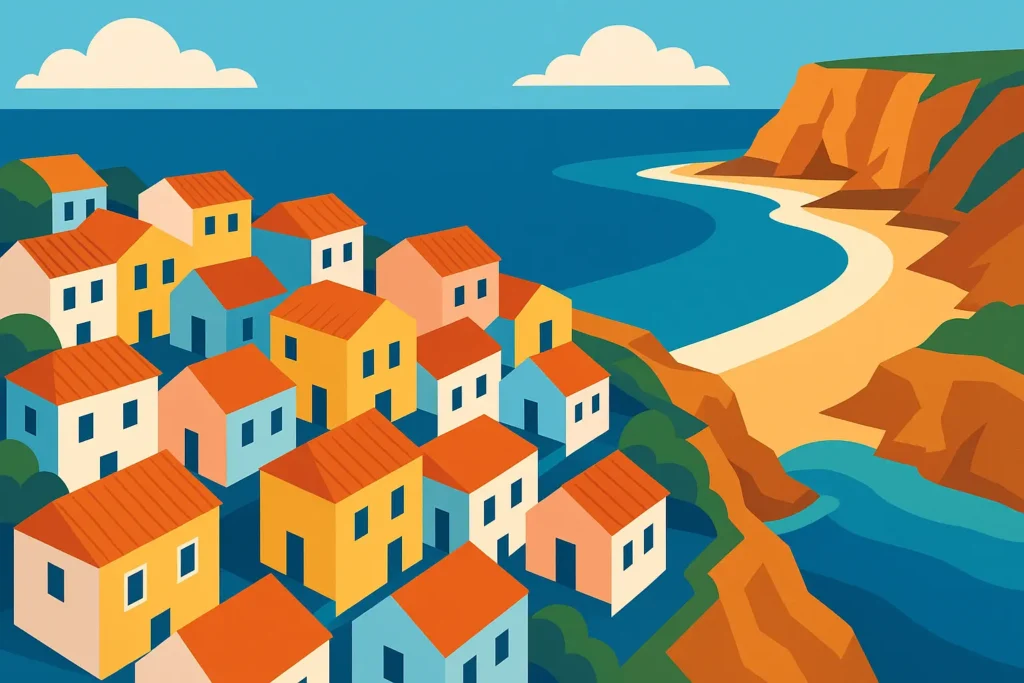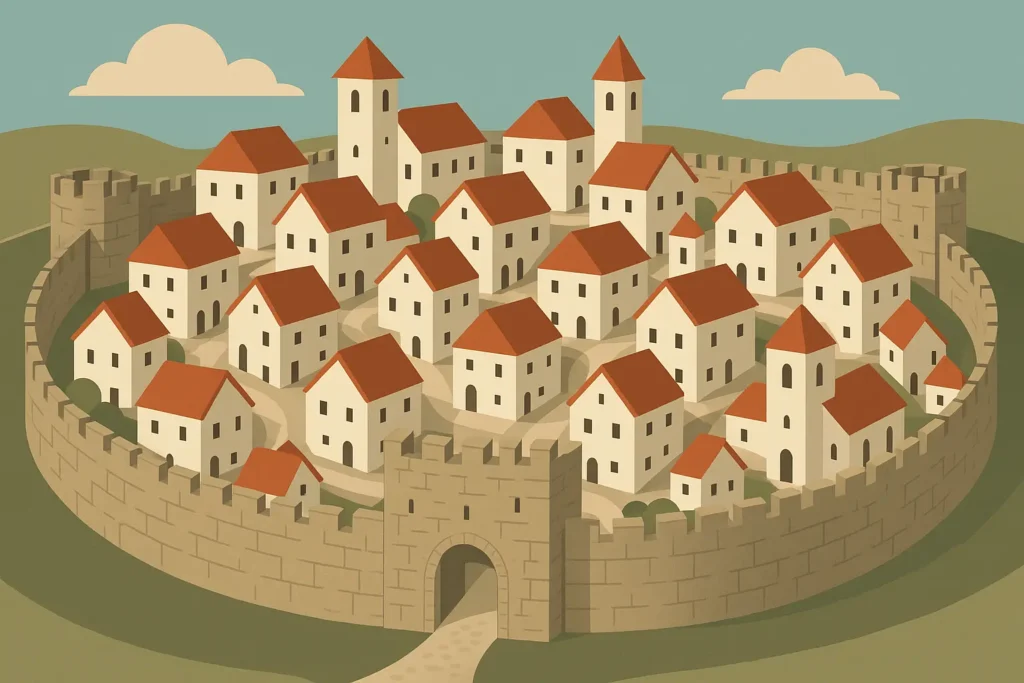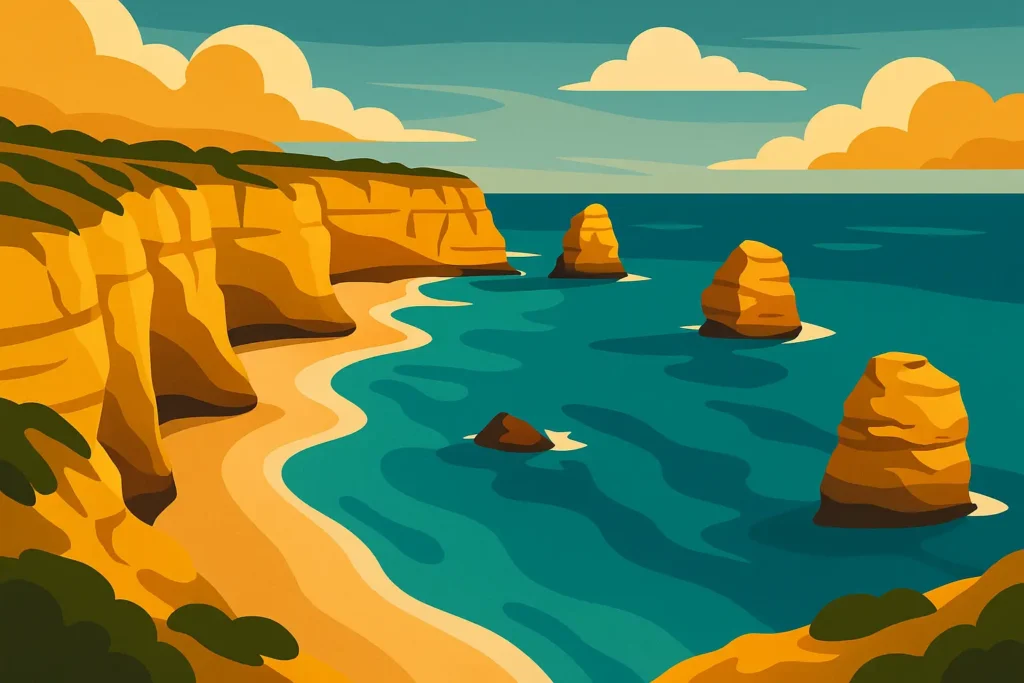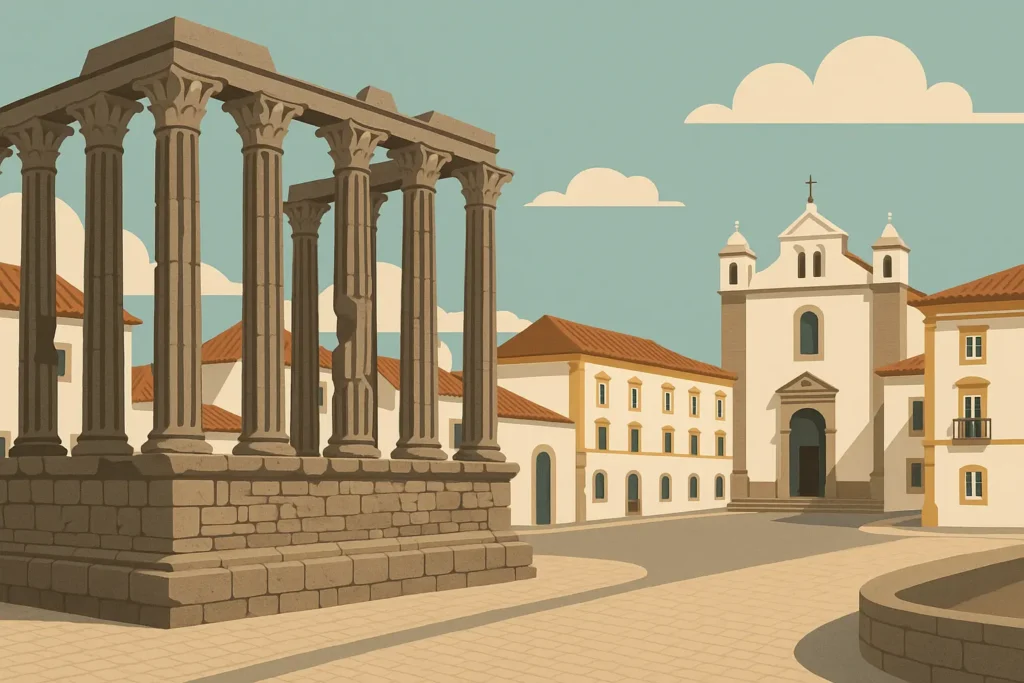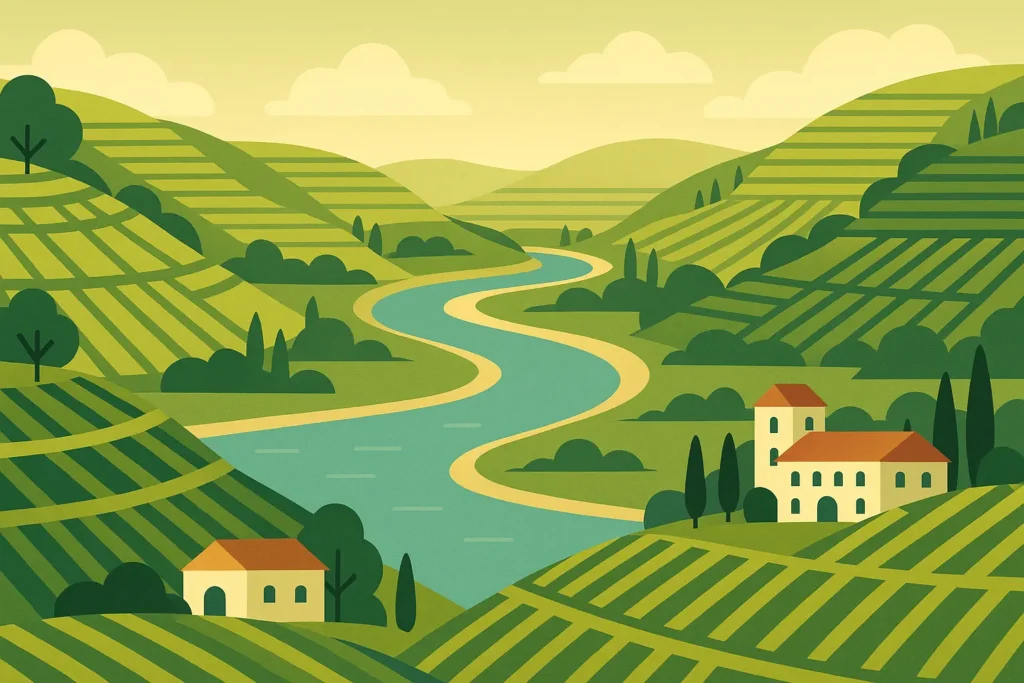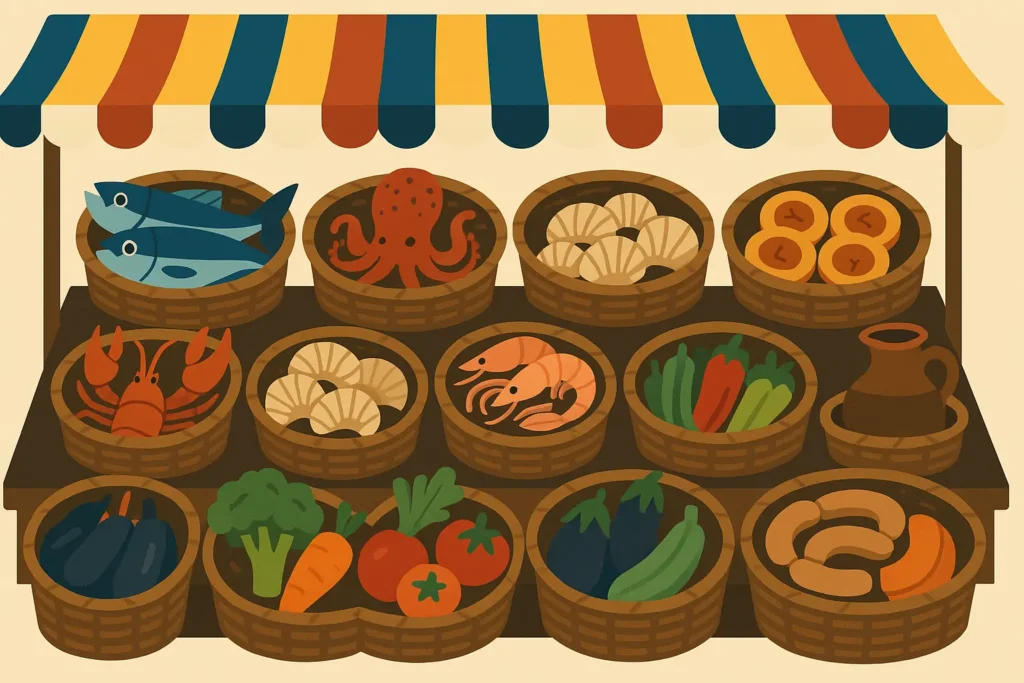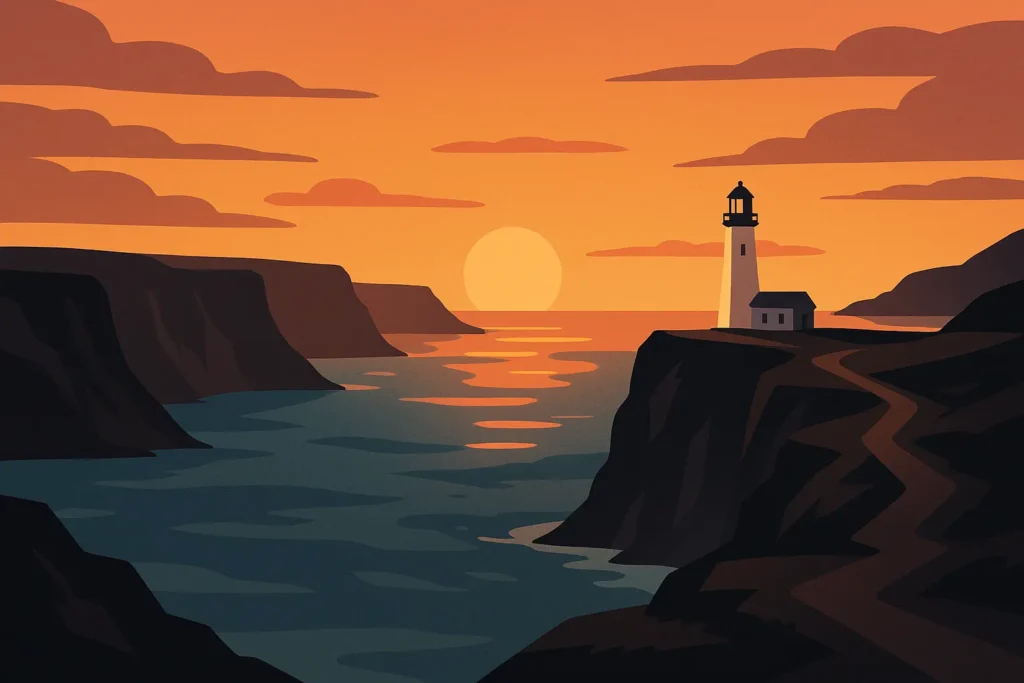Portugal has become one of Europe’s hottest travel spots, with visitor numbers jumping 12% every year according to recent tourism data from Earth Trekkers. I remember scrolling through Instagram last year, completely mesmerized by photos of colorful Porto buildings and those insane Algarve cliffs, thinking Portugal seemed too good to be true.
After planning my own trip (and making some seriously rookie mistakes along the way – like booking a rental car for Lisbon when the parking situation is an absolute nightmare), I realized that picking the right portugal itinerary can make or break your Portuguese adventure. Look, I’ve put together 25 awesome portugal itinerary options that actually work, covering everything from quick romantic getaways to epic cultural deep-dives, so you don’t have to deal with the overwhelm of endless planning decisions.
Skip the stress and plan smart with our Vacation Planner
Quick Resources:
-
Build your perfect getaway with the Vacation Planner
-
Get expert help with your celebration using the Free 24/7 Wedding Hotline
-
Bachelorette trip to Portugal? Use the Bachelorette Party Planner
-
Explore all our Wedding Planning Tools
TL;DR
- Portugal offers 25+ totally different trip options across six categories: classic first-timer routes, beach escapes, cultural journeys, adventure trips, food tours, and romantic getaways
- First-timers should stick to 2-3 regions max for trips under 10 days – trust me, you don’t want to spend more time traveling than actually exploring
- Spring (March-May) and fall (September-November) are the sweet spot for weather and avoiding crowds
- Transportation varies by region – trains work great between major cities, but you really need a car for rural areas and beach hopping
- Budget anywhere from €60-500+ per day depending on how fancy you want to get
- Each trip type serves different vibes, from history nerds to beach bums to adventure junkies
The beauty of planning a portugal itinerary lies in the country’s incredible diversity packed into such a manageable size – you can literally go from medieval castles to pristine beaches in a couple hours.
What Makes Portugal Perfect for Every Type of Traveler
Portugal’s magic lies in its ability to completely surprise you. One morning you’re exploring 800-year-old monasteries, and by afternoon you’re sipping wine overlooking terraced vineyards that look like they belong in a fairy tale. The country’s size means you can experience dramatic coastal cliffs, historic city centers, and mountain villages all within a single week without feeling rushed.
Weather-wise, you can visit year-round, though each season has its own personality. Summer brings perfect beach conditions but higher prices and tourist crowds that can be overwhelming. Winter gives you cultural exploration with hardly any tourists and rock-bottom prices. Spring and fall are the sweet spot with mild temperatures and reasonable costs.
Portugal’s compact size and crazy diverse landscapes create unique opportunities to experience multiple environments without spending half your vacation in transit. Plus, it’s way more affordable than other Western European destinations, with excellent infrastructure and locals who are genuinely welcoming. From medieval villages that time forgot to pristine beaches to volcanic islands to wine valleys, Portugal delivers authentic experiences without the crowds you’ll find in Spain or France.
| Season | Best For | The Good Stuff | The Not-So-Good | Your Wallet |
|---|---|---|---|---|
| Spring (Mar-May) | First-timers, Culture lovers | Perfect weather, fewer crowds, everything’s blooming | Some rain, tourist stuff might be closed | Reasonable (€80-150/day) |
| Summer (Jun-Aug) | Beach bums, Island hopping | Amazing weather, long days, everything’s open | Crazy crowds, expensive everything | Ouch (€120-300/day) |
| Fall (Sep-Nov) | Wine tours, Sightseeing | Harvest season, comfortable temps, good deals | Shorter days, weather can be moody | Pretty good (€70-140/day) |
| Winter (Dec-Feb) | Culture nerds, Budget travelers | No crowds, best prices, real local vibes | Limited outdoor stuff, short days | Your bank account will thank you (€60-100/day) |
Planning your trip to portugal gets way easier when you understand these seasonal vibes and can match them to what you actually want to do.
Not sure when to go? The Vacation Planner helps match your perfect timing
Classic First-Timer Itineraries
1. The Golden Triangle (7 Days)
Route: Lisbon (3 days) → Óbidos (day trip) → Porto (3 days) → Aveiro (day trip)
Start your Portuguese adventure in Lisbon, where you’ll spend three days getting lost in neighborhoods from historic Alfama (those hills will destroy your calves, fair warning) to trendy Príncipe Real. That famous Tram 28 everyone talks about? It’s touristy but honestly gives you the best overview of the city – just grab a seat on the right side for better views.
Óbidos makes a perfect pit stop – this medieval walled town takes about half a day to explore, and you absolutely have to try the cherry liqueur served in chocolate cups (it’s touristy but delicious). The drive to Porto takes about 3 hours, which sets you up perfectly for exploring northern Portugal.
Porto deserves three full days for its UNESCO historic center, port wine cellars, and those incredible azulejo tiles everywhere. A day trip to Aveiro shows off colorful boats and Art Nouveau architecture – they call it “Portuguese Venice,” which is a bit of a stretch, but it’s pretty charming.
This route covers Portugal’s two major cities plus some adorable day trips, giving first-timers all the essential Portuguese experiences without feeling rushed. You get urban exploration, medieval charm, manageable travel distances, and solid transportation connections throughout.
Sarah’s Real Talk: “As a first-timer to Portugal, I followed the Golden Triangle route and honestly, it was perfect for someone who gets overwhelmed easily. My first morning in Lisbon, I hopped on Tram 28 around 9am – any later and you’re sardined in with tourists. The Sintra day trip was magical but exhausting – I booked Pena Palace tickets online (do this or you’ll be disappointed!) and spent 4 hours there. My feet were killing me by the end. That Óbidos stop on the way to Porto felt like stepping into a storybook, and the cherry liqueur definitely helped with the driving stress. Porto’s port wine cellars were the perfect way to end – we did three tastings and I was definitely tipsy by dinner time.”
Creating the perfect portugal travel itinerary often starts with this classic route that doesn’t try to do too much at once.
Let our Vacation Planner help you build your dream itinerary
2. Lisbon to Porto Express (5 Days)
Route: Lisbon (2 days) → Coimbra (1 day) → Porto (2 days)
Perfect for when you’re short on time or just want to hit the highlights without feeling rushed. Two days in Lisbon covers the must-sees like Jerónimos Monastery and Belém Tower, plus you can actually explore neighborhoods instead of just checking boxes.
Coimbra makes a perfect break between the big cities – it’s home to one of Europe’s oldest universities and that library that looks like something out of Harry Potter. The city has this cool student energy that’s totally different from Lisbon and Porto.
Porto’s two days give you enough time for the historic center plus some serious port wine education in Vila Nova de Gaia. The train connections make this super easy without needing to deal with rental cars and parking headaches.
This streamlined version focuses on Portugal’s absolute essentials for travelers who don’t have weeks to spare. You get major cities plus Coimbra as this cool cultural bridge between north and south, maximizing what you see without the travel fatigue.
3. Capital Plus Coast (6 Days)
Route: Lisbon (2 days) → Sintra (1 day) → Cascais (1 day) → Lagos (2 days)
Start with Lisbon’s essential experiences before heading to Sintra’s palace complex. Pena Palace looks like Disney designed a castle while high – it’s absolutely wild and you need to see it to believe it. Quinta da Regaleira has these mystical gardens with underground tunnels that are Instagram gold.
Cascais gives you sophisticated coastal vibes with great beaches and fancy dining. This former fishing village turned posh resort town eases you into Portuguese coastal culture without the Algarve crowds.
Lagos in the Algarve delivers those dramatic cliff formations at Ponta da Piedade that break your Instagram. Some of Europe’s most photographed beaches are here, and two days lets you do boat tours, beach time, and explore the historic town without rushing.
This combo gives you Lisbon’s urban attractions plus Portugal’s most famous coastal spots, perfect for people who want both culture and beach time. You see the diversity Portugal offers within just the central and southern regions.
Plan a smooth coast-to-city trip with our Vacation Planner
4. Historic Heart Discovery (8 Days)
Route: Lisbon (2 days) → Évora (1 day) → Monsaraz (1 day) → Coimbra (2 days) → Porto (2 days)
Lisbon’s two days focus on the history that actually matters – from Age of Discovery monuments in Belém to Moorish influences in Alfama. The city gives you context for understanding how tiny Portugal ended up having such a massive global impact.
Évora shows off Roman heritage with its temple and that bone chapel that’s equal parts creepy and fascinating. Nearby Monsaraz gives you medieval vibes overlooking this massive reservoir. These Alentejo towns show you Portugal’s interior character, which is totally different from the coast.
Coimbra’s university and library represent Portugal’s educational heritage – that library seriously looks like Hogwarts. Porto’s historic center shows off northern Portuguese architecture and culture. Fair warning: you’ll need a rental car for the Alentejo portions.
This UNESCO-focused route appeals to history buffs who want to really understand Portuguese heritage beyond just the pretty buildings. You connect major historical sites while getting context for Portugal’s role in European and world history.
5. North to South Sampler (10 Days)
Route: Porto (2 days) → Douro Valley (2 days) → Coimbra (1 day) → Lisbon (3 days) → Algarve (2 days)
Starting in Porto gets you immediately into northern Portuguese culture and port wine traditions. Two days covers the historic center, wine cellars, and essential neighborhoods without feeling rushed.
The Douro Valley is wine country at its most dramatic – river cruises and quinta visits in this UNESCO landscape with terraced vineyards that look like they were carved by giants. The train ride alone is worth the trip.
Coimbra bridges north and south perfectly, while Lisbon’s three days lets you really explore including day trips to Sintra. The Algarve finale gives you beach relaxation and those coastal views that made you want to visit Portugal in the first place.
This comprehensive overview covers Portugal’s diverse regions from Douro wine country to Algarve beaches, ideal for travelers who want to experience everything the country offers. You get major cities plus distinctive regional experiences that show off Portugal’s incredible variety.
When planning your trip to portugal, this sampler gives you the most complete introduction to everything the country has to offer.
Beach and Coastal Itineraries
6. Algarve Beach Hopper (7 Days)
Route: Lagos (2 days) → Sagres (1 day) → Tavira (2 days) → Faro (2 days)
Lagos serves as your western Algarve base, home to Ponta da Piedade’s golden cliffs that look like nature’s sculpture gallery. Those hidden beaches accessible by boat tours? Totally worth the seasickness if you’re prone to it. The town’s historic center and marina give you evening entertainment when you’re beached out.
Sagres is literally Europe’s southwestern tip – they used to call it “The End of the World,” and standing on those dramatic cliffs, you get why. The ocean views are powerful and the seafood restaurants serve fish that was swimming that morning.
Tavira shows off the eastern Algarve’s chiller personality with Roman bridges, island beaches, and traditional Portuguese architecture that hasn’t been completely touristified. The Ria Formosa Natural Park here is this unique ecosystem that bird nerds go crazy for.
Faro combines regional capital conveniences with barrier island access. The old town’s cathedral and bone chapel are cool contrasts to the pristine beaches you reach by ferry – and yes, another bone chapel, Portugal loves these things.
This coastal exploration covers the Algarve’s diverse beach landscapes from those dramatic western cliffs to peaceful eastern islands. You get active exploration balanced with serious relaxation time, showcasing Portugal’s most famous beach region through totally different coastal experiences.
7. Silver Coast Explorer (5 Days)
Route: Nazaré (2 days) → Óbidos (1 day) → Peniche (1 day) → Ericeira (1 day)
Nazaré gives you world-famous giant wave viewing (winter months) and traditional fishing culture that hasn’t been completely sanitized for tourists. The upper and lower towns connected by this ancient funicular offer totally different perspectives on Portuguese coastal life.
Óbidos adds medieval charm to your coastal journey, with castle walls and that cherry liqueur everyone talks about. This perfectly preserved town takes about half a day to explore completely, so don’t overplan.
Peniche delivers authentic fishing port vibes with incredible seafood and nearby Berlengas Islands for day trips if you want to feel like you’re on the edge of the world. The town’s fortress and traditional boat-building add some cultural depth to all the beach time.
Ericeira rounds out the journey with world-class surfing beaches and this laid-back coastal atmosphere that makes you want to learn to surf. This World Surfing Reserve has consistent waves and a surf culture that’s welcoming to beginners.
This route focuses on Portugal’s less crowded western coastline, giving you authentic coastal experiences without the Algarve crowds and prices. You get traditional fishing villages, dramatic ocean scenery, and excellent surfing conditions all in one trip.
8. Island Paradise Escape (6 Days)
Route: Madeira – Funchal (2 days) → Santana (1 day) → Porto Moniz (1 day) → Calheta (2 days)
Funchal provides urban island sophistication with botanical gardens, cable car rides to nowhere, and restaurants that’ll ruin you for seafood anywhere else. The city’s markets and historic center offer cultural immersion alongside modern amenities.
Santana showcases those traditional thatched houses that look like hobbit homes and gives you access to mountain hiking trails. This UNESCO Biosphere Reserve protects unique flora and fauna – basically, it’s really pretty and unspoiled.
Porto Moniz features natural volcanic swimming pools that are like nature’s infinity pools, plus dramatic coastal scenery. The town’s location on Madeira’s northwestern tip provides sunset viewing that’ll break your camera.
Calheta offers golden sand beaches (rare in Madeira, where most beaches are black volcanic rock) and marina facilities. The levada walks here and sugar cane museum add cultural and natural exploration when you need a beach break.
Madeira’s subtropical climate means year-round appeal for island experiences without Caribbean prices. This route balances Funchal’s urban amenities with the island’s natural wonders, from levada walks to dramatic coastal formations that don’t exist anywhere else.
9. Azores Adventure (8 Days)
Route: São Miguel – Ponta Delgada (2 days) → Sete Cidades (2 days) → Furnas (2 days) → Nordeste (2 days)
Ponta Delgada serves as your base with historic city gates, marina, and pineapple plantations (yes, really). The capital has excellent restaurants and cultural sites while positioning you for island exploration that feels like another planet.
Sete Cidades offers twin crater lakes in blue and green that look photoshopped but aren’t, surrounded by hiking trails and viewpoints that’ll make your Instagram followers hate you. This volcanic caldera represents the Azores’ most iconic landscape.
Furnas combines hot springs with unique cooking methods using volcanic heat – they literally bury your dinner in the ground and let the earth cook it. The Terra Nostra Park’s thermal pools and botanical gardens create this unique spa experience that feels like a fantasy novel.
Nordeste showcases tea plantations (the only ones in Europe) and dramatic coastal viewpoints. This quieter region provides authentic Azorean culture and some of the island’s most spectacular scenery without the crowds.
São Miguel Island packs volcanic landscapes, hot springs, and crater lakes into a compact area perfect for week-long exploration. This route balances natural wonders with cultural experiences, showcasing the Azores’ unique position between Europe and America – it’s like nowhere else you’ve been.
Cultural and Historic Itineraries
10. UNESCO World Heritage Trail (9 Days)
Route: Lisbon (2 days) → Sintra (1 day) → Tomar (1 day) → Batalha/Alcobaça (1 day) → Évora (2 days) → Porto (2 days)
Lisbon’s UNESCO sites include Jerónimos Monastery and Belém Tower, representing Portugal’s Age of Discovery achievements when this tiny country basically ruled the seas. The city’s historic neighborhoods give you context for understanding how Portugal ended up having such massive global influence.
Sintra’s Cultural Landscape includes multiple palaces and gardens, from Pena Palace’s fairy-tale romanticism to Quinta da Regaleira’s mystical symbolism. A full day barely scratches the surface – you could spend a week here and still find new stuff.
Tomar’s Convent of Christ reveals Templar history and Manueline architecture that’ll blow your mind. This fortress-monastery complex shows Portugal’s religious and military heritage through multiple historical periods all in one place.
Batalha and Alcobaça monasteries showcase Gothic architecture and royal connections. These massive religious complexes need several hours each – don’t try to rush through them or you’ll miss the incredible details.
Évora’s Roman Temple and historic center represent 2,000 years of continuous habitation. The city’s university, cathedral, and bone chapel (seriously, Portugal loves these bone chapels) create this comprehensive cultural experience.
Porto’s historic center demonstrates northern Portuguese architecture and urban planning. The city’s azulejo tiles, baroque churches, and port wine heritage complete your UNESCO journey with some serious wine education.
This comprehensive cultural journey connects Portugal’s UNESCO World Heritage Sites, giving you deep historical context and architectural appreciation. The itinerary for portugal requires decent walking ability for monument exploration and works year-round with both indoor and outdoor experiences.
11. Medieval Villages Circuit (6 Days)
Route: Óbidos (1 day) → Monsaraz (1 day) → Marvão (1 day) → Castelo Rodrigo (1 day) → Sortelha (1 day) → Monsanto (1 day)
Óbidos gives you the perfect medieval introduction with complete wall circuits you can walk around and that cherry liqueur tradition. This tourist-friendly village has comfortable accommodations and excellent restaurants, so it’s a gentle start.
Monsaraz overlooks the Alqueva reservoir from its hilltop position, maintaining this authentic medieval atmosphere that makes you feel like you time-traveled. The village’s narrow streets and castle ruins create photography opportunities that don’t need filters.
Marvão occupies this dramatic mountain-top position near the Spanish border that’s absolutely wild. This fortress town’s strategic location and preserved architecture show you what medieval defensive planning looked like when your neighbors weren’t friendly.
Castelo Rodrigo combines castle ruins with almond orchards that are particularly stunning during spring blooming season. The village’s Jewish quarter and medieval streets reveal diverse cultural influences you don’t expect.
Sortelha’s granite boulder construction creates unique architectural character – they literally built around massive rocks. This fortified village maintains traditional crafts and gives you authentic rural Portuguese experiences.
Monsanto earned designation as “Most Portuguese Village” for its integration with massive granite boulders. The settlement’s unique construction methods and traditional lifestyle offer authenticity that’s getting rare in Europe.
This hidden gems tour reveals Portugal’s best-preserved medieval settlements, each offering unique architectural features and historical significance. You’ll need a rental car but the reward is authentic experiences completely away from tourist crowds.
12. Religious Heritage Journey (7 Days)
Route: Fátima (2 days) → Batalha (1 day) → Alcobaça (1 day) → Tomar (1 day) → Braga (2 days)
Fátima serves as Portugal’s primary pilgrimage destination, where apparitions of the Virgin Mary occurred in 1917. The sanctuary complex accommodates millions of annual visitors with impressive modern and traditional architecture – it’s moving even if you’re not religious.
Batalha Monastery represents royal patronage and Gothic architecture at its absolute finest. This Dominican monastery’s construction spanned multiple centuries, creating this architectural evolution within a single complex that’s mind-blowing.
Alcobaça houses Portugal’s largest church and Cistercian monastery. The complex’s kitchen, dormitories, and royal tombs give you insight into monastic life and royal connections – the kitchen alone is bigger than most apartments.
Tomar’s Convent of Christ reveals Templar and Order of Christ history through its unique round church and Manueline decorations. This fortress-monastery shows the evolution from military to religious orders in one incredible place.
Braga represents northern Portugal’s religious capital with multiple sanctuaries and baroque churches. Bom Jesus do Monte’s hydraulic elevator and zigzag stairway create one of Portugal’s most photographed religious sites – and the views are incredible.
This spiritual and architectural tour connects Portugal’s most significant religious sites, from pilgrimage destinations to monastic complexes. It appeals to both religious travelers and anyone interested in ecclesiastical architecture and the history that shaped Portugal.
13. Roman and Moorish Legacy (8 Days)
Route: Évora (2 days) → Beja (1 day) → Mértola (1 day) → Silves (1 day) → Tavira (1 day) → Estremoz (2 days)
Évora’s Roman Temple and aqueduct remains show imperial presence, while the city’s layout reflects both Roman and Moorish planning principles. The cathedral and university add medieval and Renaissance layers – it’s like reading history through architecture.
Beja showcases Roman foundations with its castle and regional museum. This Alentejo town’s archaeological collections and Moorish influences provide context for southern Portugal’s complex history that most people don’t know about.
Mértola occupies this strategic river position that attracted Romans, Visigoths, and Moors. The town’s mosque-turned-church and archaeological sites reveal continuous occupation through multiple civilizations – it’s like an archaeology textbook come to life.
Silves served as the Moorish capital of the Algarve, with its red sandstone castle dominating the landscape. The cathedral and archaeological museum display artifacts from Islamic and Christian periods, showing how cultures blended and clashed.
Tavira’s Roman bridge and Islamic influences in its architecture demonstrate the peaceful coexistence of cultures. The town’s churches built on mosque foundations illustrate religious transitions that weren’t always violent.
Estremoz combines Roman marble quarries with medieval fortifications. This marble town’s castle and traditional pottery workshops maintain connections to ancient crafts and materials that are still used today.
This archaeological and cultural journey explores Portugal’s ancient civilizations, from Roman settlements to Moorish influences. You focus on southern and central Portugal where these historical layers remain most visible in architecture, urban planning, and cultural traditions.
Adventure and Nature Itineraries
14. Douro Valley Wine and Nature (5 Days)
Route: Porto (1 day) → Peso da Régua (2 days) → Pinhão (2 days)
Porto provides essential port wine education at Vila Nova de Gaia cellars before heading into the Douro Valley proper. The city’s wine lodges offer tastings and historical context – basically Wine 101 before you get to the advanced course.
Peso da Régua serves as the Douro’s administrative center with excellent train connections and river cruise departures. The Douro Museum provides comprehensive wine region education and cultural context that makes the rest of your trip way more meaningful.
Pinhão represents the valley’s heart with its famous azulejo train station and surrounding quintas. This small town offers intimate wine experiences and hiking trails through terraced vineyards that look like they were carved by giants.
River cruises between towns provide unique perspectives on the landscape – you really can’t appreciate the scale until you’re on the water. Quinta visits offer wine tastings paired with traditional Portuguese meals that’ll ruin you for chain restaurants forever. The scenic train journey ranks among Europe’s most beautiful rail experiences.
This UNESCO landscape combines wine culture with river scenery and terraced vineyard hiking. You get wine education balanced with outdoor activities, offering both cultural immersion and natural beauty in Portugal’s premier wine region.
| Activity Type | Best Season | Duration | Difficulty Level | Cost Range (€) |
|---|---|---|---|---|
| River Cruise | Apr-Oct | 2-8 hours | Easy (just sit and drink) | 25-150 |
| Quinta Wine Tasting | Year-round | 1-3 hours | Easy (more drinking) | 15-50 |
| Vineyard Hiking | Mar-Nov | 2-6 hours | Moderate (those hills are real) | Free-25 |
| Scenic Train Ride | Year-round | 2-3 hours | Easy (scenic napping) | 15-35 |
| Hot Air Balloon | Apr-Oct | 3-4 hours | Easy (expensive views) | 180-250 |
15. Central Portugal Mountains (6 Days)
Route: Serra da Estrela (2 days) → Monsanto (1 day) → Piódão (1 day) → Aveiro (2 days)
Serra da Estrela offers Portugal’s highest peaks with hiking trails, traditional cheese production that’ll change your life, and mountain villages where time stopped decades ago. Winter brings skiing opportunities (yes, really), while summer provides excellent hiking conditions.
Monsanto’s granite boulder integration creates unique architecture and dramatic landscapes. This “Most Portuguese Village” maintains traditional lifestyles and offers authentic mountain culture that tourism hasn’t completely ruined yet.
Piódão showcases schist architecture in this dramatic valley setting that looks like it belongs in a fantasy movie. This preserved village’s terraced gardens and traditional crafts demonstrate sustainable mountain living practices.
Aveiro provides coastal relaxation after mountain adventures, with its colorful boats, Art Nouveau architecture, and nearby beaches. The city’s canals and traditional sweets offer gentle cultural experiences when your legs need a break from hiking.
This mountain adventure explores Portugal’s highest peaks and traditional villages, combining hiking opportunities with cultural immersion. You need good fitness levels and it provides authentic experiences in less-visited regions where you’ll actually meet locals.
16. Northern Wilderness (7 Days)
Route: Peneda-Gerês National Park (3 days) → Viana do Castelo (2 days) → Braga (2 days)
Peneda-Gerês National Park offers waterfalls, glacial lakes, and traditional villages with granite granaries that look like they’re from another century. Wildlife includes wild horses, eagles, and endemic plant species in protected habitats.
Hiking trails range from easy walks to challenging mountain climbs that’ll test your fitness, with overnight accommodation in traditional villages or eco-lodges. The park’s hot springs provide relaxation after active days when your muscles are screaming.
Viana do Castelo combines coastal beauty with historic architecture. The Santa Luzia Sanctuary offers panoramic views that are worth the climb, while the Gil Eannes ship museum provides maritime history.
Braga serves as northern Portugal’s religious capital with multiple sanctuaries and baroque churches. The city’s historic center and nearby Guimarães day trip complete your northern adventure with some serious cultural depth.
Portugal’s only national park provides hiking, wildlife viewing, and traditional village experiences that feel completely authentic. You need a rental car and good fitness levels but it rewards adventurous travelers with wilderness experiences that are getting rare in Europe.
17. Rota Vicentina Walking Trail (8 Days)
Route: Sagres (2 days) → Vila do Bispo (2 days) → Aljezur (2 days) → Sines (2 days)
Sagres provides trail access from Europe’s southwestern tip, with dramatic cliff formations and powerful ocean views that make you feel like you’re at the edge of the world. The town’s fortress and maritime museum add historical context to all the natural beauty.
Vila do Bispo offers traditional village atmosphere with access to pristine beaches and coastal trails. Daily hiking distances range from 10-20 kilometers through protected coastal landscapes – it’s challenging but totally doable if you’re reasonably fit.
Aljezur combines Moorish castle ruins with excellent surfing beaches. This traditional town provides authentic Portuguese culture alongside outdoor adventure opportunities without the tourist crowds.
Sines completes the trail with its connection to Vasco da Gama’s birthplace and industrial port facilities. The contrast between natural beauty and modern development illustrates Portugal’s economic evolution – it’s not all pretty, but it’s real.
This coastal hiking trail follows dramatic cliffs and pristine beaches along Portugal’s southwestern coast. You get daily hiking combined with comfortable accommodations, appealing to active travelers seeking coastal wilderness experiences.
Culinary and Wine Itineraries
18. Northern Gastronomy Tour (6 Days)
Route: Porto (2 days) → Douro Valley (2 days) → Viana do Castelo (1 day) → Braga (1 day)
Porto’s culinary scene includes traditional francesinha sandwiches (basically a heart attack on a plate, but SO worth it), fresh seafood, and innovative restaurants that’ll surprise you. The city’s markets, food tours, and cooking classes provide hands-on learning opportunities.
Port wine cellars offer tastings paired with regional cheeses and traditional sweets that you can’t get anywhere else. The city’s riverside restaurants specialize in grilled sardines and other Atlantic seafood that tastes like it was swimming this morning.
Douro Valley quintas combine wine tastings with traditional Portuguese meals prepared using local ingredients. Many estates offer cooking classes focusing on regional specialties and wine pairings that’ll change how you think about food.
Miguel’s Real Experience: “I’m a chef from California, and Portugal’s northern food scene completely blew my mind. In Porto, I took a cooking class where we made francesinha from scratch – the sauce alone has 12 ingredients and took 3 hours! The Douro Valley quinta we visited served this 7-course meal paired with their wines, each dish highlighting local ingredients like mirandesa beef and regional cheeses I’d never heard of. What surprised me most was learning that Portuguese cuisine varies dramatically by region – the northern dishes were heartier and way more influenced by Atlantic seafood than I expected. I filled two notebooks with recipes and techniques that I’m definitely stealing for my restaurant.”
Viana do Castelo’s coastal location provides excellent seafood restaurants and traditional recipes that haven’t been touristified. The town’s markets showcase regional products including traditional breads and pastries.
Braga’s religious festivals influence local cuisine, with special breads and sweets prepared for celebrations. The city’s traditional restaurants maintain recipes passed down through generations – it’s like eating history.
This food-focused journey explores northern Portugal’s distinctive cuisine, from Porto’s francesinha sandwiches to Douro wine pairings. You get restaurant experiences combined with market visits and cooking classes for comprehensive culinary immersion.
19. Central Portugal Food Trail (5 Days)
Route: Coimbra (1 day) → Leiria (1 day) → Nazaré (1 day) → Óbidos (1 day) → Caldas da Rainha (1 day)
Coimbra’s university town atmosphere creates diverse dining options from student taverns to upscale restaurants. The city’s traditional sweets and regional wines reflect academic and religious influences – plus student prices mean great value.
Leiria’s central location provides access to both mountain and coastal ingredients. Local restaurants specialize in game dishes, traditional breads, and regional wine varieties that you won’t find elsewhere.
Nazaré’s fishing heritage dominates local cuisine with fresh seafood preparations and traditional preservation methods. The town’s restaurants offer authentic fishing community recipes, not tourist versions.
Óbidos combines medieval atmosphere with cherry liqueur traditions and regional pastries. The town’s restaurants within castle walls provide unique dining experiences that feel like dinner theater.
Caldas da Rainha’s thermal springs influence local cuisine with health-focused preparations and traditional spa foods. The town’s markets showcase regional pottery alongside local produce – it’s a feast for all your senses.
This culinary exploration focuses on central Portugal’s traditional recipes and local markets, emphasizing authentic experiences over tourist restaurants. You get cooking classes and market visits for hands-on food education that you can actually use at home.
20. Alentejo Wine Country (7 Days)
Route: Évora (2 days) → Estremoz (2 days) → Vila Viçosa (1 day) → Monsaraz (2 days)
Évora serves as the regional capital with excellent restaurants and wine bars showcasing Alentejo varieties that most people have never heard of. The city’s markets and cooking classes provide insight into regional ingredients and techniques.
Wine estates around Évora offer tastings in traditional cellars and modern facilities. Many quintas provide accommodation and meals prepared with estate-grown ingredients – it’s farm-to-table before that was trendy.
Estremoz’s marble town atmosphere complements wine experiences with traditional pottery workshops and regional crafts. Local restaurants specialize in Alentejo lamb and pork preparations that’ll ruin you for supermarket meat.
Vila Viçosa’s royal connections influence local cuisine with refined preparations and historical recipes. The town’s palace and traditional restaurants maintain aristocratic culinary traditions without the pretentious attitude.
Monsaraz overlooks the Alqueva reservoir with wine estates producing unique varieties influenced by the microclimate. Sunset wine tastings provide spectacular views over Europe’s largest artificial lake – it’s romantic even if you’re traveling solo.
This wine-focused journey explores Portugal’s largest wine region, combining estate visits with traditional Alentejo cuisine. You get cork forests, wine education, and authentic rural experiences in areas where tourism hasn’t completely taken over yet.
21. Lisbon Foodie Experience (4 Days)
Route: Lisbon neighborhoods – Alfama (1 day) → Bairro Alto (1 day) → Príncipe Real (1 day) → Belém (1 day)
Alfama’s traditional fado houses combine music with authentic Portuguese cuisine. The neighborhood’s narrow streets hide family-run restaurants serving traditional recipes unchanged for generations – it’s like eating at your Portuguese grandmother’s house.
Bairro Alto transforms from quiet daytime neighborhood to vibrant nightlife district. The area’s restaurants range from traditional tascas to innovative contemporary Portuguese cuisine that’s getting international recognition.
Príncipe Real represents Lisbon’s trendy food scene with gourmet markets, artisanal food shops, and innovative restaurants. The neighborhood’s food tours showcase modern Portuguese culinary evolution while respecting traditional techniques.
Belém combines historical significance with culinary traditions, home to the original pastéis de nata recipe (and yes, they’re way better than the copies). The area’s restaurants specialize in seafood and traditional Portuguese sweets.
This urban culinary adventure explores Lisbon’s diverse neighborhoods through their distinctive food cultures. The portugal itinerary combines traditional pastéis de nata with contemporary Portuguese cuisine, market visits, and neighborhood food tours that show you how locals actually eat.
Romantic and Special Occasion Itineraries
22. Romantic Getaway (5 Days)
Route: Sintra (2 days) → Cascais (1 day) → Óbidos (2 days)
Sintra’s palace hotels and quinta accommodations provide luxury settings surrounded by romantic gardens and mountain views that look like fairy tale illustrations. Private palace tours and horse-drawn carriage rides create intimate experiences without the tourist crowds.
Pena Palace and Quinta da Regaleira offer settings so romantic they’re almost cheesy – but in the best way possible. The town’s traditional pastries and wine tastings add culinary romance to all the visual beauty.
Cascais provides sophisticated coastal elegance with upscale restaurants and sunset beach walks that don’t require hiking boots. The former royal resort maintains refined atmosphere perfect for romantic dinners where you can actually hear each other talk.
Óbidos’ medieval walls and castle accommodations create storybook romance that feels authentic, not manufactured. The town’s cherry liqueur tradition and intimate restaurants within ancient buildings provide unique romantic experiences you can’t get anywhere else.
This intimate itinerary combines fairy-tale palaces with coastal romance and medieval charm, perfect for couples seeking romantic experiences without the crowds. You get luxury accommodations, private experiences, and scenic settings ideal for creating those memories you’ll actually want to remember.
23. Honeymoon Luxury (10 Days)
Route: Lisbon luxury hotel (3 days) → Douro Valley quinta (3 days) → Algarve resort (4 days)
Lisbon’s luxury hotels provide urban sophistication with rooftop pools, spa services, and Michelin-starred restaurants. Private city tours and exclusive experiences create memorable honeymoon moments without the stress of planning everything yourself.
Helicopter transfers to the Douro Valley add drama to your romantic journey that’ll make great stories later. Luxury quintas offer private wine tastings, couples’ spa treatments, and gourmet meals with valley views that don’t need Instagram filters.
River cruises on private boats and hot air balloon rides provide unique perspectives on the UNESCO landscape. Evening wine tastings on quinta terraces create intimate romantic settings where you can actually relax.
Algarve luxury resorts provide beachfront suites, private beach access, and world-class spa facilities. Golf courses, yacht charters, and private beach dinners complete the luxury experience without feeling over-the-top.
This premium itinerary emphasizes luxury accommodations, private experiences, and romantic settings across Portugal’s most beautiful regions. The extended timeframe allows for unhurried experiences and spontaneous romantic moments instead of rushing through a checklist.
24. Anniversary Celebration (7 Days)
Route: Porto wine lodges (2 days) → Douro river cruise (2 days) → Sintra palace hotels (3 days)
Porto’s historic wine lodges offer private tastings and exclusive cellar tours that feel special without being stuffy. Luxury accommodations in converted palaces or boutique hotels provide elegant settings for anniversary celebrations.
Multi-day river cruises provide all-inclusive luxury with gourmet meals, wine tastings, and scenic viewing from private suites. Shore excursions to quintas offer intimate wine experiences away from group tours.
Sintra’s palace hotels create fairy-tale settings perfect for anniversary celebrations that feel magical, not cheesy. Private palace tours, romantic dinners, and couples’ spa treatments mark your special milestone appropriately.
This milestone celebration itinerary emphasizes exclusive experiences and premium accommodations perfect for marking special anniversaries. You get wine culture combined with romantic settings and luxury amenities that justify the splurge.
25. Proposal Perfect (4 Days)
Route: Lisbon (1 day) → Sintra (2 days) → Cascais (1 day)
Lisbon’s miradouros provide stunning sunset proposal settings overlooking the city and Tagus River. Luxury restaurants and rooftop bars offer intimate dinner options following your special moment – assuming everything goes according to plan.
Sintra’s palace gardens and romantic viewpoints create multiple proposal opportunities in case your first choice doesn’t work out. Pena Palace terraces, Quinta da Regaleira’s mystical gardens, and Cabo da Roca’s dramatic cliffs provide unforgettable settings that look incredible in photos.
Professional photographers can capture your proposal moment discreetly, while luxury accommodations provide celebration settings. Private palace tours and romantic dinners complete your engagement experience without overwhelming your newly-engaged partner.
Cascais provides coastal romance with beach walks and sunset dining. The sophisticated resort atmosphere offers relaxed celebration opportunities following your engagement when you’re both probably emotionally exhausted.
This intimate itinerary focuses on romantic settings ideal for marriage proposals, combining scenic viewpoints with luxury experiences. The compact timeframe maintains focus on creating the perfect proposal moment while providing backup options if weather or crowds interfere.
How to Choose Your Perfect Portugal Itinerary
Picking the right Portugal itinerary requires honest consideration of multiple factors including how long you actually have, when you can travel, how much you want to spend, whether you’re comfortable driving, and who you’re traveling with. Understanding these elements helps match your actual travel style with appropriate itinerary categories instead of just picking what looks prettiest on Instagram.
Essential Planning Considerations
Duration significantly impacts your itinerary options. Trips under five days work best for single-region focus – don’t try to see everything or you’ll spend more time traveling than exploring. 7-10 days allow for 2-3 region exploration comfortably. Extended trips over 10 days can cover the entire country without feeling rushed.
Seasonal timing affects both costs and experiences dramatically. Spring (March-May) and fall (September-November) provide optimal weather with moderate crowds and reasonable prices. Summer offers perfect beach conditions but higher costs and tourist density that can be overwhelming. Winter suits cultural exploration with minimal crowds but limited outdoor activities.
Budget considerations vary dramatically between regions and seasons. Portugal remains affordable compared to Western European neighbors, but costs range from €60-500+ daily depending on whether you’re staying in hostels or luxury hotels, eating at local tascas or Michelin-starred restaurants.
| Itinerary Type | Ideal Duration | Best Season | Transportation | Budget Range (€/day) | Difficulty Level |
|---|---|---|---|---|---|
| Classic First-Timer | 5-10 days | Spring/Fall | Train + Car | 80-200 | Easy |
| Beach & Coastal | 5-14 days | Summer | Car/Bus | 70-250 | Easy |
| Cultural & Historic | 6-12 days | Year-round | Train + Car | 90-180 | Moderate |
| Adventure & Nature | 5-10 days | Spring/Fall | Car Required | 60-150 | Moderate-Hard |
| Culinary & Wine | 4-8 days | Fall (Harvest) | Car Preferred | 100-300 | Easy |
| Romantic & Special | 4-10 days | Spring/Fall | Mixed | 150-500+ | Easy |
Transportation preferences influence itinerary feasibility significantly. Portugal’s excellent train network connects major cities efficiently, while rental cars provide flexibility for rural areas and coastal exploration. Some itineraries absolutely require specific transportation methods for optimal experiences.
Group dynamics affect itinerary selection dramatically. Multi-generational groups prefer slower-paced cultural itineraries with comfortable accommodations, while couples might choose romantic or adventure options. Solo travelers often prefer structured cultural or culinary experiences where they can meet other people.
Matching Travel Styles to Itinerary Categories
First-time visitors benefit from classic itineraries covering essential Portuguese experiences without trying to do everything. These routes provide cultural context while maintaining manageable travel distances and excellent infrastructure.
Beach enthusiasts should focus on coastal itineraries during optimal seasons (May-October). The Algarve offers developed beach infrastructure and consistent weather, while the Silver Coast provides authentic coastal experiences with fewer crowds and lower prices.
Cultural travelers find satisfaction in UNESCO and historic itineraries requiring 6+ days for proper exploration. These routes work year-round but particularly shine during shoulder seasons with fewer crowds and better photo opportunities.
Adventure seekers need good fitness levels and appropriate seasons for outdoor activities. Spring through fall provides optimal conditions for hiking and outdoor activities, while winter limits outdoor options significantly.
Food and wine enthusiasts can choose from regional culinary itineraries, with harvest season (September-October) offering particularly special experiences. These routes accommodate various dietary restrictions with advance planning.
Romantic travelers benefit from luxury accommodations and private experiences that create memorable moments. Spring and fall provide optimal weather for romantic experiences, while summer offers extended daylight for sunset moments.
Regional Characteristics and Seasonal Considerations
Northern Portugal offers cooler, rainier weather but excellent cultural experiences and wine regions. Transportation connections work well between major cities, though rental cars help significantly for Douro Valley exploration.
Central Portugal provides transitional climate and excellent value for money. The region’s historic sites and Silver Coast beaches work year-round, with car rentals helpful for coastal exploration and medieval village visits.
Lisbon region maintains Mediterranean climate with mild winters and excellent public transportation. The area serves as an ideal base for first-time visitors with numerous day trip options accessible by train.
Alentejo’s hot summers and mild winters suit wine tourism and cultural exploration. Limited public transportation makes rental cars essential, but the region offers authentic Portuguese experiences away from tourist crowds.
The Algarve provides warmest weather and best beach conditions but varies dramatically in cost by season. Good coastal bus service exists, though cars provide flexibility for beach hopping and exploring smaller towns.
Portuguese islands offer year-round destinations with unique climates. Flights are required for access, and rental cars are recommended for comprehensive exploration of these unique environments.
Creating your perfect portugal itinerary becomes straightforward once you understand these regional differences and seasonal patterns instead of just following what looks good on social media.
Detailed Itinerary Breakdowns
These comprehensive breakdowns provide day-by-day guidance for complex itineraries, including specific activities, transportation logistics, and accommodation recommendations. The detailed examples help travelers understand practical implementation of itinerary concepts instead of just pretty descriptions.
UNESCO World Heritage Trail Deep Dive (9 Days)
Days 1-2: Lisbon Foundation
Begin at Jerónimos Monastery arriving right at opening time to avoid the tour bus crowds. This Manueline masterpiece requires 2-3 hours for complete exploration including the maritime museum – don’t rush through it.
Belém Tower provides Age of Discovery context with harbor views and architectural details that make Portugal’s maritime history come alive. The Monument to Discoveries offers panoramic city views from its elevator if you don’t mind heights.
Alfama neighborhood exploration includes Fado Museum, São Jorge Castle, and traditional restaurants where locals actually eat. Evening fado performances provide authentic Portuguese cultural experiences – book ahead or you’ll be disappointed.
Tram 28 circuit covers major city highlights efficiently, though it gets packed by 10am. Rossio Square and Chiado district offer shopping and dining opportunities when you need a break from monuments.
Day 3: Sintra Palace Complex
Pena Palace requires advance booking and 3-4 hours for palace and gardens – seriously, book online or you might not get in. The colorful Romantic architecture and mountain views create unforgettable experiences that justify the crowds.
Quinta da Regaleira’s mystical gardens and Initiation Well need 2-3 hours for complete exploration. The estate’s symbolism and underground tunnels fascinate history enthusiasts and Instagram addicts equally.
Sintra National Palace provides Portuguese royal history context, while the town center offers traditional pastries and shopping opportunities. The train from Lisbon gets packed – leave early.
Day 4: Tomar Templar Heritage
Convent of Christ demonstrates Templar evolution into Order of Christ through architectural layers that tell Portugal’s religious and military history. The round church and Manueline window require several hours for proper appreciation.
Tomar’s historic center includes the Synagogue and traditional Portuguese architecture. The town’s riverside location provides pleasant walking opportunities when you need a monument break.
Day 5: Monastic Masterpieces
Batalha Monastery showcases Gothic architecture and royal connections that demonstrate Portuguese ambition. The Founder’s Chapel and Unfinished Chapels show what happens when royal money runs out.
Alcobaça Monastery houses Portugal’s largest church and impressive Cistercian architecture. The kitchen, dormitories, and royal tombs provide monastic life insights – the kitchen alone is bigger than most modern apartments.
Days 6-7: Évora Cultural Immersion
Roman Temple and bone chapel represent 2,000 years of continuous habitation in one city. The cathedral and university add medieval and Renaissance layers to this historical lasagna.
Day trip to megalithic sites including Almendres Cromlech provides prehistoric context that predates everything else. Traditional Alentejo dining experiences showcase regional cuisine and wines that you can’t get elsewhere.
Days 8-9: Porto Historic Finale
Historic center exploration includes São Bento Station’s azulejo tiles, Livraria Lello bookstore (yes, the Harry Potter one), and Torre dos Clérigos views that justify the climb.
Port wine cellar tours in Vila Nova de Gaia provide wine education and tastings that’ll ruin you for regular wine. Evening riverside dining completes your UNESCO journey with serious food and wine.
Simple Itinerary Examples
Golden Triangle Practical Implementation
Lisbon base allows Sintra day trips via train (40 minutes each way) – much easier than driving and dealing with parking nightmares. Book Pena Palace tickets online to avoid disappointment during peak seasons.
Óbidos stopover works perfectly when driving to Porto, requiring only 2-3 hours for wall walking and cherry liqueur tasting. Don’t overplan this – it’s small.
Porto’s three days include one full day for historic center exploration, one day for port wine experiences, and one day for Aveiro excursion via train – the “Portuguese Venice” thing is overselling it, but it’s charming.
Algarve Beach Hopper Logistics
Lagos provides western Algarve base with boat tours to Ponta da Piedade’s golden cliffs that look photoshopped but aren’t. Book tours in advance during summer months or you’ll be disappointed.
Sagres day trip includes Cabo de São Vicente lighthouse and dramatic cliff walks that make you feel like you’re at the end of the world. Seafood restaurants offer excellent lunch options with ocean views.
Tavira’s Roman bridge and Ria Formosa islands require ferry transportation that’s part of the experience. Island beaches provide pristine swimming and bird watching opportunities away from the crowds.
Faro combines regional capital amenities with old town exploration and barrier island access via ferry services. The airport location makes it a convenient final stop.
The Thompson Family’s 10-Day Reality Check: “We used the North to South Sampler itinerary for our family trip with teenagers, and honestly, it was almost too much. Starting in Porto was perfect – the kids loved the Harry Potter connection at Livraria Lello (though we waited 45 minutes in line) and the port wine cellars offered non-alcoholic tastings for them. The Douro Valley train ride was absolutely magical, and staying at a quinta made everyone feel special, though it was expensive. Coimbra’s university library amazed our bookworm daughter, while Lisbon’s trams and elevators kept our son entertained when he was getting cranky. The Algarve finale was perfect for family beach time after all that culture. The 10-day pace worked well – not too rushed but covering everything we wanted to see. Car rental for Douro and Algarve portions was essential, but trains worked perfectly between major cities. Pro tip: book everything in advance during summer.”
Planning your trip to portugal becomes much more manageable when you see these practical implementation examples instead of just dreamy descriptions.
Planning Your Portugal Adventure with Professional Support
Planning a Portugal itinerary can feel overwhelming with 25+ options across six categories, each requiring different considerations for transportation, timing, and logistics. Just as couples planning destination weddings benefit from professional coordination to avoid disasters, travelers seeking the perfect Portuguese experience can benefit from expert guidance to navigate the complexities of creating memorable trips without the stress.
Whether you’re considering a romantic proposal in Sintra’s fairy-tale gardens (and panicking about weather backup plans), planning a honeymoon across Portugal’s diverse regions, or organizing a destination wedding celebration in the Douro Valley, having professional support can transform your Portuguese dreams into seamless reality instead of a logistical nightmare.
Planning a Portugal proposal or honeymoon? Try our Vacation Planner
The same attention to detail that makes wedding planning successful – from coordinating vendors to managing timelines and handling unexpected challenges like weather or transportation strikes – applies perfectly to crafting the ideal Portugal itinerary. Professional travel coordination ensures every aspect runs smoothly, from restaurant reservations that don’t get lost in translation to transportation logistics that actually work.
If you’re planning a destination wedding or honeymoon in Portugal, consider reaching out to Bridesmaid for Hire for comprehensive planning support. Our expertise in managing complex celebrations and creating stress-free experiences translates perfectly to destination wedding coordination and honeymoon planning that focuses on romance instead of logistics.
Need help planning your Portugal celebration? Call our Free 24/7 Wedding Hotline
Ready to start planning your perfect Portugal adventure? Contact Bridesmaid for Hire today to discuss how we can help coordinate your Portuguese destination wedding or honeymoon, ensuring every detail is handled with the same care and expertise that makes weddings unforgettable – so you can focus on actually enjoying your trip.
Final Thoughts
Portugal offers incredible diversity within a compact, affordable package that accommodates every travel style and budget without breaking the bank or your sanity. From medieval villages that time forgot to pristine beaches that don’t require a mortgage to visit, volcanic islands to wine valleys, the country delivers authentic experiences without overwhelming crowds or the pretentious attitudes you’ll find in some European destinations.
The 25 itineraries presented here provide frameworks for exploration, but Portugal’s real magic lies in unexpected discoveries – that perfect sunset viewpoint nobody told you about, the family-run restaurant serving recipes unchanged for generations, or the spontaneous conversation with locals that provides cultural insights no guidebook can capture and Google Translate can barely handle.
Whether you choose a classic first-timer route or an adventurous island exploration, Portugal rewards travelers who embrace both planned experiences and serendipitous moments. The key to a successful Portuguese adventure lies in selecting the right itinerary for your actual travel style (not your Instagram aspirations) and remaining open to the country’s ability to surprise and delight at every turn.
Portugal and its incredible diversity make it one of Europe’s most rewarding destinations, offering something special for every type of traveler willing to explore beyond the obvious tourist paths and embrace the unexpected adventures that make trips memorable.
1-800-BRIDESMAID
The Newlywed
Card Game
something extra to love
Read the weekly newsletter from Bridesmaid for Hire, 1-800-Bridesmaid, to hear about real stories, from strangers, who need advice on love, life, friendship, and so much more.
Looking for the perfect wedding gift for someone you adore? Grab The Newlywed Card Game. It's a fun and interactive game they can play on their honeymoon or future date nights.

